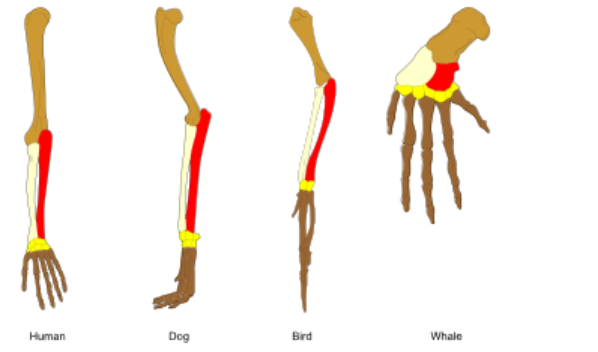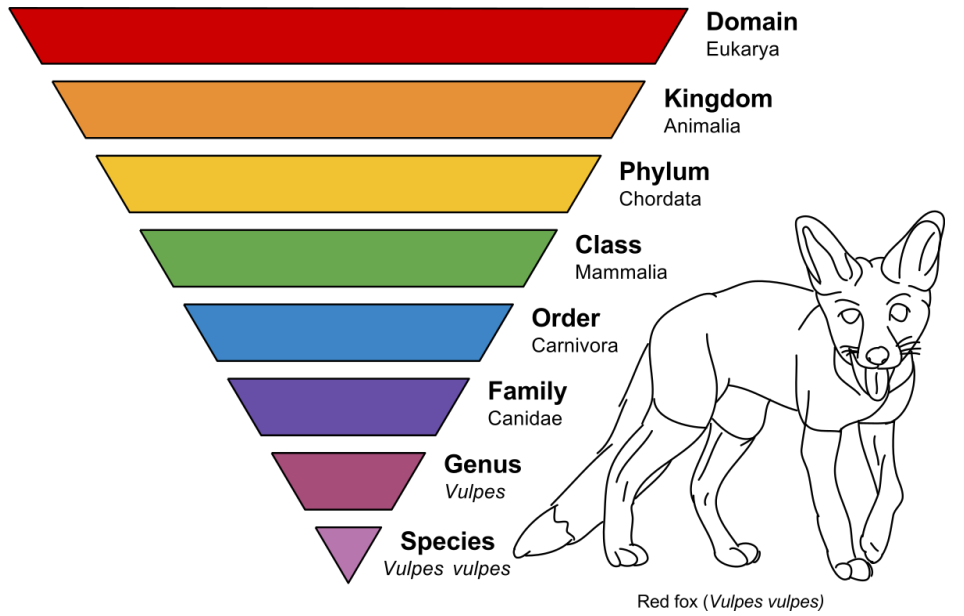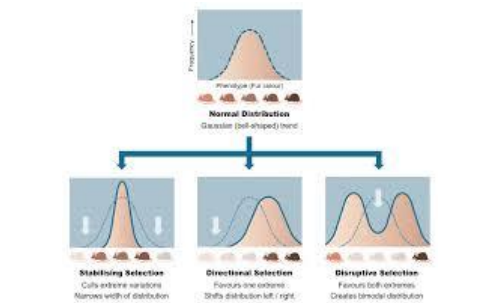A. Natural Selection
➢ Charles Darwin
- British naturalist who sailed the world
- Developed theory of evolution based on natural selection after studying animals on Galapagos Islands
- Observed that there were similar animals on isolated animals, but they each had slight variations (ex. Beak shape, neck length, etc.)
■ There must have originally been a variety of beak lengths, but only the longest ones could survive. Since those with the longest beaks could reproduce better, they were more likely to contribute offspring with the same traits to the next generation - The Origin of Species
■ Variation exists in the population and some of this variation is heritable
■ Populations tend to make lots of offspring
■ Resources are limited, thus a struggle ensues
■ Those with better traits (phenotypes) will do a better job getting those resources and reproduce more
■ The genes that code for “better” traits in the current environment start increasing in the population
● The earth is always changing what what may be good now may not be in the future; evolution will always be occurring
➢ “Survival of the fittest”
➢ Jean-Baptiste Lamarck
- Widely accepted theory of evolution in Darwin’s
- Acquired traits inherited and passed onto offspring
■ “Law of use and disuse”
■ According to Lamarck, giraffes have long necks because they constantly use them - WRONG
■ Changes in somatic cells do not change gametes and thus cannot be passed onto offspring
➢ Evidence for Evolution
○ Paleontology
■ Study of fossils
■ Revealed great variety of organisms and the major lines of evolution
■ Tend to form in sedimentary rock
- Biogeography
■ Study of the distribution of flora and fauna in the environment
■ Related species found in widely separated regions of the world
■ Suggests a common ancestor between species
■ Ex: pangea - Embryology
■ Study of the development of an organism
■ Early stages of vertebrate development all look alike
● All vertebrates show fishlike “gill slits” - Comparative anatomy
■ Study of anatomy of various animals
■ Vestigial Strucutres
● Structures with little-no function
● Remannts of structures that served important functions in the organism’s ancestors
■ Homologous structures
● Similar structures that serve different functions
■ Analogous structures
● Same function different structure

- Molecular biology
■ Most compelling proof of evolution
■ Examining nucleotide/amino acid sequences of different organisms
■ Common genes and proteins
■ Ex: Hox Genes (body paint controller genes)
■ Shared structures help us to understand not only how structures develop but also supports shared shared ancestry - Artificial Selection
■ Humans selecting which organisms reproduce and survive so the future generations have traits that humans have selected
■ Ex. dog breeds
B. Common Ancestry
➢ Phylogenetic trees
- Aka cladogram
- Study the relationships between organisms
- Begin with common ancestor and then branch out
- Anytime there is a fork in the road, it is called a common ancestor node
■ Common ancestors likely do not exist anymore, but they are the point at which evolution went in two directions - Outgroup
■ Related to ingroup but diverged before others
■ Serves as reference group
■ Always stems from foot of tree
- Monophyletic=ancestral species+all descendants
- Paraphyletic=ancestral species+some descendants
- Polyphyletic=ancestral species+descendants+distantly related organism
- Taxonomic categories
■ DOMAIN
■ KINGDOM
■ CHORDATA
■ PHYLUM
■ CLASS
■ ORDER
■ FAMILY
■ GENUS
■ SPECIES

C. Genetic Variability
➢ Genetic variability: differences in each person/individual
➢ Only identical twins have exactly identical sets of alleles
➢ Survival of a species is dependent on genetic variation, allowing a species to survive in a changing environment
- Natural selection only occurs if some individuals have more evolutionary fitness and can be selected
➢ Cause of genetic variability
- Random mutations
- DNA polymerase errors
- Changes to DNA by transposons, etc.
- Meiosis
■ Crossing-over
■ Independent assortment - Bacteria
■ Conjugation
■ Transduction
● Viruses pass around chunks of the bacterial genome during infection
D. Causes of Evolution
➢ Natural selection works internally through random mutations and externally through environmental pressures
➢ As long as a mutation does not kill an organisms before it reproduces, it may be passed on to the next generation
➢ Advantages brought about by a mutation will only be apparent until environmental pressure occurs
➢ Adaptation: variation favored by natural selection
➢ Any trati that causes an individual to reproduce better gives that individual evolutionary fitness
➢ Sexual selection can also spur evolution
➢ Speciation occurs once 2 populations can no longer reproduce together
- Biological Species Theory
■ Species is a group of populations whose members have the potential to interbreed in nature and produce fertile, viable offspring
■ They do not breed successfully with other populations
➢ Catastrophic events speed up natural selection
➢ Genetic drift
- Something that causes a change in a population besides natural selection
- Caused by random events that drastically reduce the number of individuals in a population
- Bottleneck effect
■ Sudden change in environment reduces size of population
■ New gene pool is not reflective of original population - Founder effect
■ Few individuals become so isolated from larger population and establish a new popluation that may not be representative of original population - Gene Flow
■ Tends to make a population more similar
■ When a poppulation gains/loses alles by genetic additions/subtractions from population - Only a few individuals are left to mate and regrow a population, so their traits become overemphasized without necessarily having any reproductive advantage
➢ Types of SElection
- Directional selection favors one extreme of the normal distribution
- Stabilizing selection: extreme traits are selected against
- Disruptive selection favors both extremes,common traits selected against

E. Species
➢ Divergent evolution
- In order for a population to split into different species, they must be reproductively isolated
- Allows the two groups to undergo natural selection and evolve differently
- a population evolves into 2 separate species due to different variation/environmental pressures until the 2 groups can no longer mate together
- Prezygotic barriers prevent fertilization
■ Habitat isolation
● 2 species don’t encounter each other
● Same geographic area, but different habitats
■ Temporal Isolation
● Species breed during different times of da/season/etc.
■ Behavioral Isolation
● Different courting rituals
● Species do not respond to mating signals
■ Mechanical isolation
● Unsuccessful mating attempt
● Species are anatomically incompatible
■ Gametic isolation
● Sperm unable to fertilize eggs
● Gametes are unable to fuse to forma zygote - Post-zygotic barriers are related to the inability of the hybrid to survive/reproduce
■ Reduced hybrid viability
● Genes impair hybrid development
■ Reduced hybrid fertility
● Sterile hybrids
■ Hybrid breakdown
● Weaker hybrids over generations
● Offspring of htbrids are weak/sterile
➢ Convergent evolution
- Process by which two unrelated and dissimilar species come to have analogous traits
- Often due to exposure to similar selective pressures
➢ 2 types of speciation
- Allopatric
■ Population becomes separated from the rest of the species by a geographic barrier so the 2 population can interbreed - Sympatric
■ New species form without any geographic barrier
■ Common in plants
■ Through polyploidy, sexual selection, habitat differentiation, etc.
➢ Polyploidy
- Presence of extra sets of chromosomes due to accidents during cell division
- Common in plants
➢ Autopolyploidy
- Individual with more than two chromosome sets
- derived from same species
➢ Allopolyploid
- Species with multiple sets of chromosomes derived from different species (interbreeding)
F. Population Genetics
➢ Hardy-Weinberg Equilibrium
- Law states that even with all the shuffling of genes that goes on, the relative frequencies of genotypes in a population still prevail over time, creating a stable gene pool
- 5 Conditions
■ Large population
■ No mutations
■ No immigration/emigration
■ Random mating
■ Natural selection - All populations violate one of these five–populations are always evolving
➢ p + q = 1
➢ $\square^2+2 \square \square+\square^2=1$
